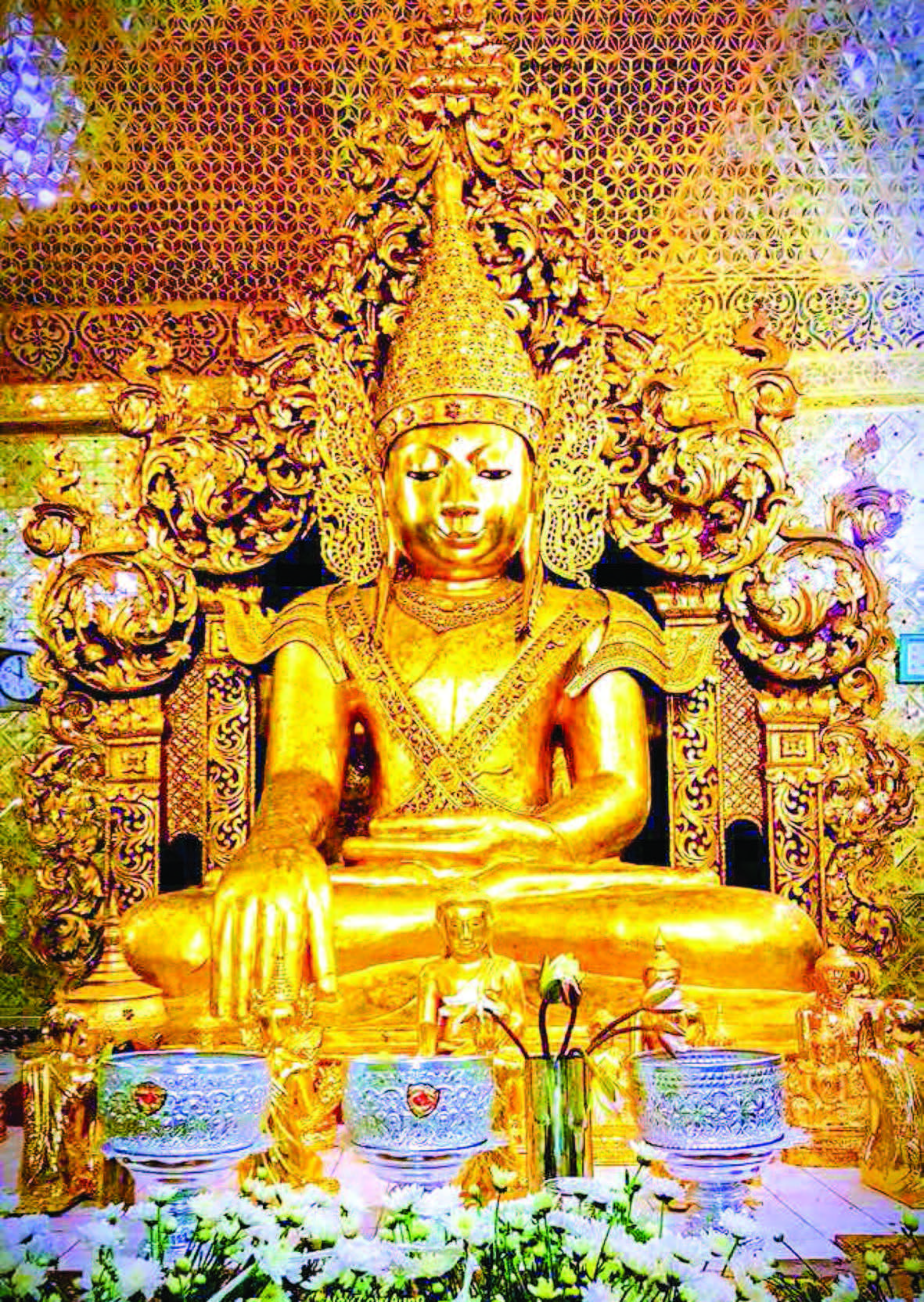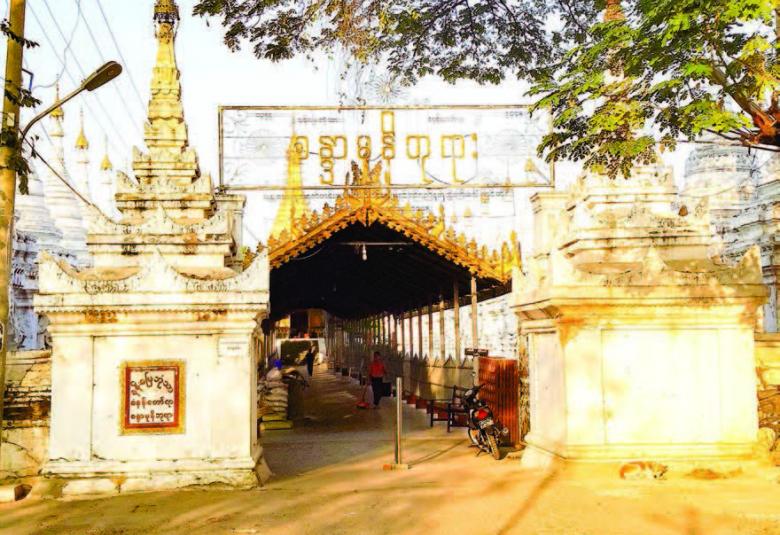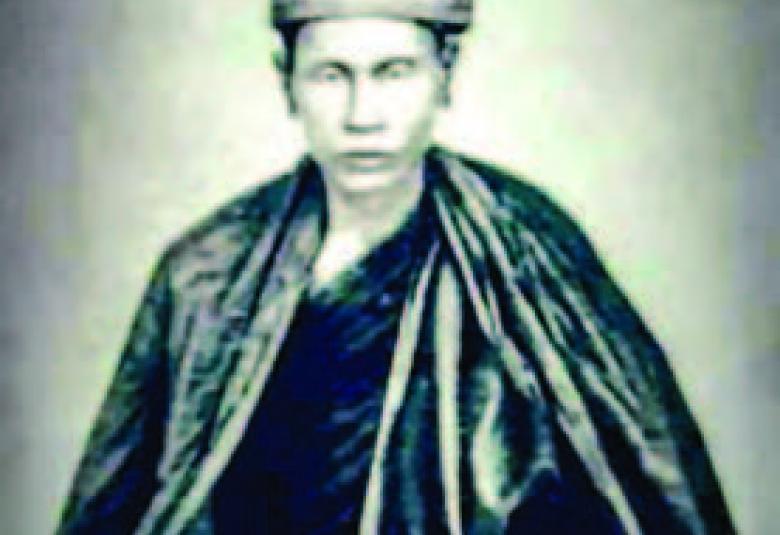By Maung Tha (Archaeology)
STONE inscriptions bearing Pitakat treatises dubbed as the Memory of the World recognized by UNESCO take positions in the precinct of Kuthodaw Pagoda at the foot of Mandalay Hill. Likewise, similar stone inscriptions of Tri Pitakat treatises and Tika treatises which can be called the second memory of the world are located in the precinct of Çandamuni Stupa near Kuthodaw Pagoda.
Çandamuni Stupa takes a position between Maha Lawkamarazein Kuthodaw Pagoda and Maha Thakyamunirazein Kyauktawgyi Pagoda at the foot of Mandalay Hill. Travellers have easy access to the stupa on the way to Mandalay Hill. Hermit U Khanti erected 1,772 stone plaques of treatises and two record stone plaques in the precinct of Çandamuni Stupa.
Nanmyay Bontha Çandamuni Stupa takes a position at the corner of 66th street and State Pariyatti Sasana University, northeast corner of the moat of Mandalay royal palace and 200 yards south to Mandalay Hill. The archway of the stupa bears the title of Nanmyay Bontha Sannandawya Çandamuni Stupa.
King Mindon established Yadanabon Mandalay in 1221 Myanmar era. He often took a rest at Nanmyay Bontha in visiting Kyauktawgyi Pagoda, joining ploughing ceremony and inspecting Yadana Nadi Dam.
The book on history of Çandamuni Stupa mentioned that the area of Nanmyay Bontha built by King Mindon would be much larger than the precinct of current Çandamuni Stupa. U Maung Maung Tin who compiled the Great History of Konbaung Dynasty recorded that after completion of the royal palace, buildings for queens and other buildings in the compound, the Çandamuni Buddha Image. royal palace was named as NanBy Maung Tha (Archaeology) 14 15 23 MAY 2020 THE GLOBAL NEW LIGHT OF MYANMAR 23 MAY 2020 ART & CULTURE THE GLOBAL NEW LIGHT OF MYANMAR ART & CULTURE 15 Çandamuni Stupa. Hermit U Khanti. myay Bontha in line with the choice of scholars.
An uprising led by Prince Myinkun and Prince Myinkhontaing occurred at the shut near the court of Nanmyay Bontha on 2 August 1866. In the event, princess including Crown Prince Kanaung and Myataung governor gun minister were killed. The remains of the crown prince were kept into the coffin in the main building of the royal palace. Eleven months later, the main building was dissolved on 6 June 1867. Remains of Crown Prince Kanaung, Prince Malun, Prince Saku and Prince Pyinsi were buried in the tombs. The urn pagoda was built on the plot, about three feet from the tomb, according to Great History of Konbaung Dynasty.
Tomb of Crown Prince Kanaung
The site of Nanmyay Bontha Royal Palace was taken by Çandamuni Buddha Image and stupa. A tomb assumed as a graveyard where the remains of Prince Kanaung and other princes were buried took place near the pagoda. Later, the tomb was dissolved on 20 June 1992 because officials assumed the tomb was not magnificent for the pagoda. In the site, a stone plaque bearing the profile of Prince Kanaung was erected.
A story was expressed on the stone plaque in Myanmar and English, bearing that Crown Prince Kanaung was born of King Thayawady and Queen Kyaukmaw on 27 September 1819. He participated in establishment of Yadanabon Mandalay Royal Palace. He made efforts for improving Myanmar economy and led to equip Myanmar royal armed forces with modern arms. The crown prince was killed in the incident of Myinkun-Myinkhontaing uprising on 2 August 1866.
Çandamuni Buddha Image
King Badon, the founder of Amarapura Royal City, cast Çandamuni Buddha Image weighing 11,368 viss of iron on 14th waxing of Tagu, 1164 Myanmar era and kept it in the golden tier-roofed building, northeast of Mingun Alekyun Palace. The image was moved to the place, 100 yards north of the old moat of Amarapura on 12th waning of Tawthalin, 1177 ME. Maha Çandamuni Pagoda on the left side of Mandalay-Amarapura Road was built by King Badon 13 years ago after casting Çandamuni Buddha Image.
King Sagaing conveyed the image from Amarapura to the precinct of Inwa Maha Muni Buddha Image on 5th waning of Wagaung, 1189 ME. The Buddha image was kept in the golden Gandakuti chamber. Eleven years later, King Thayawady conveyed the image to Amarapura on 8th waning of Tawthalin, 1200 ME. The image was conveyed by King Mindon to Yadanabon Mandalay from Amarapura in 1229 ME. The walls of the stupa built by King Mindon were 730 feet long from the east to the west, 365.5 feet wide from the south to the north and six feet high.
The king built the 100 feet high stupa on the five-terrace brick foundation and the seven-tier brick Gandakuti chamber in the east of the pagoda where Çandamuni Buddha Image was kept. The chamber was 36 feet long and 34.5 feet wide.
Hermit U Khanti donated
stairways made iron frames at four dimensions of the stupa. The hermit safeguarded and maintained the stupa from 1269 ME to 1311 ME.
Atthakatha and Tika treatises
Dhamma stupas, where stone plaques bear treatises of Atthakatha and Tika of the Lord Buddha, were built in the precinct of Çandamuni Stupa. These stone inscriptions were curved by Hermit U Khanti under permission of Maha Sangharaja in 1275 ME.
The Sangharaja assigned 15 venerable members of the Sangha to edit the inscriptions. Finally, Abhayarama Moehti Monastery Abbot U Jagara supervised expression of stone inscriptions.
One to three stone plaques were erected on brick tables on which one stupa each was built in the precinct of Çandamuni Stupa.
Thuthiri Thinkhawady, daughter of Crown Prince Kanaung, supplicated to Hermit U Khanti that if Kuthodaw Pagoda built by King Mindon was formed with stone plaques bearing treatises of Tri Pitakat, Çandamuni Stupa where the tomb of the crown prince took place should have been formed with stone plaques bearing inscriptions of Atthakatha and Tika treatises.
The hermit could build the brick stupas on 883 stone plaques. Now, remaining 891 stone plaques have been kept in the chambers. A total of 454 stone plaques were kept in 194 chambers at the northeast corner of the stupa, 454 plaques in 194 chambers at the southeast corner, 432 plaques in 184 chambers at the southwest corner and 432 plaques in 184 chambers at the northwest corner.
Hermit U Khanti
The history of Mandalay Hill could not complete without records on endeavours of Hermit U Khanti who decorated the hill with prayer halls and stairways made of iron frames and concrete ladders.
He was born of U Shwe Hla and Daw Kan aka Daw Kho U in Ywatha Village of Yamethin Township on fifth waning of Wagaung, 1229 ME and passed away on 14th waning of Pyatho, 1310 ME.
The youth, named Maung Po Maung, was ordained at 20 at Kyaungma Monastery in Yamethin Township.
At 12 vassa, he was initiated into hermit and he resided at Shwemyintin Hill. In 1908, the hermit moved to Mandalay and focused on construction of religious edifices, totalling 47 buildings in 20 towns. During the period from 1908 to 1949, the religious edifices on Mandalay Hill built by the hermit were valued at K11,639,980.
Stone inscriptions on Tri Pitakat and Atthakatha treatises can be seen in Yangon, Meiktila, Thaton, Hinthada, Kyangin, Aphyauk, Mingun and Mandalay.
Among them, number of stone plaques in the precinct of Çandamuni Stupa in Mandalay was the largest. In fact, these stone plaques were Buddhist literature as donations of Hermit U Khanti in addition to historic Çandamuni Stupa and Çandamuni Buddha Image.
(Translated Than Tun Aung)
References: Great History of Konbaung Dynasty (U Maung Maung Tin) Mandalay Hill (Ludu Daw Ahmar) New History of Mandalay Hill (Bhaddanta Jotikabhivamsa) History of Çandamuni Stupa and Dhammazedi stone plaques (U Aung Thu)





